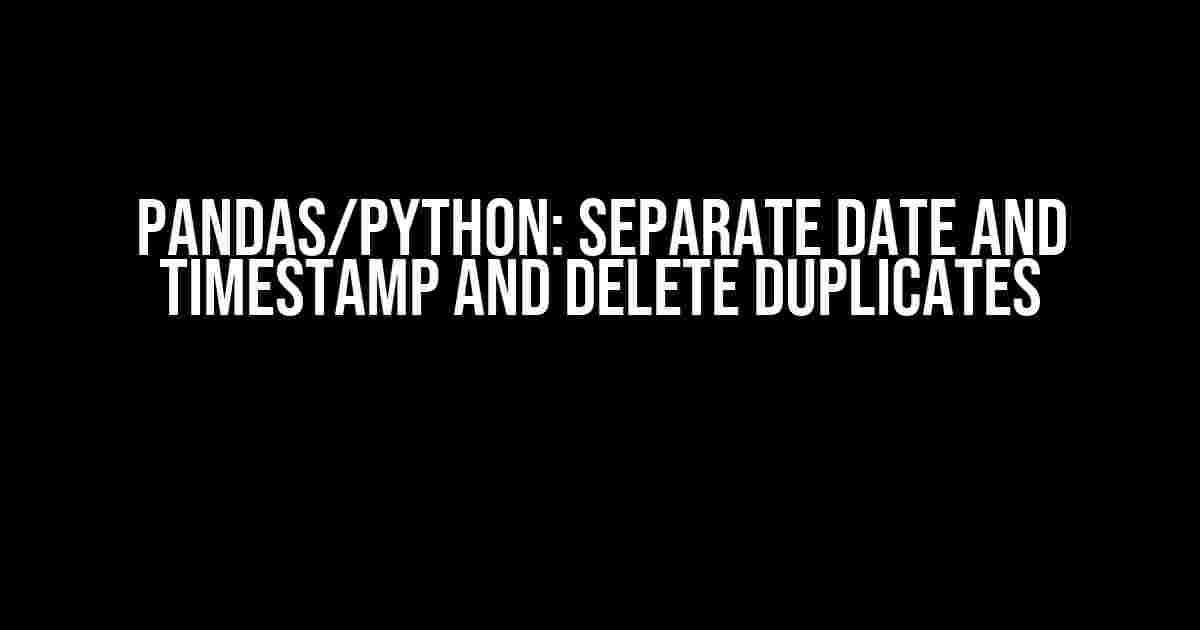Welcome to this comprehensive guide on how to separate date and timestamp in pandas/Python and delete duplicates. In this article, we will explore the world of data manipulation using pandas, one of the most powerful libraries in Python. By the end of this tutorial, you’ll be a master of handling dates and timestamps, and deleting duplicates like a pro!
Why Separate Date and Timestamp?
Before we dive into the technical details, let’s take a step back and understand why separating date and timestamp is important. When working with datetime columns in pandas, it’s often useful to separate the date and timestamp into individual columns. This can be beneficial for various reasons:
- Easy filtering and grouping: Separate date and timestamp columns allow for easy filtering and grouping based on specific dates or time ranges.
- Better data analysis: Having separate columns for date and timestamp enables more accurate data analysis, such as calculating daily or hourly aggregates.
- Improved data visualization: Separating date and timestamp can lead to more insightful data visualizations, as you can display date and timestamp information separately.
Python and Pandas Setup
Before we begin, make sure you have Python installed on your system, along with the pandas library. If you don’t have pandas installed, you can install it using pip:
pip install pandasNow, let’s import the necessary libraries and create a sample dataset to work with:
import pandas as pd
import numpy as np
# Create a sample dataset
data = {'datetime': ['2022-01-01 10:00:00', '2022-01-01 11:00:00', '2022-01-01 12:00:00',
'2022-01-02 10:00:00', '2022-01-02 11:00:00', '2022-01-02 12:00:00'],
'value': [10, 20, 30, 40, 50, 60]}
df = pd.DataFrame(data)Separating Date and Timestamp
Now that we have our sample dataset, let’s separate the date and timestamp into individual columns. We can achieve this using the dt accessor in pandas:
df['date'] = df['datetime'].dt.date
df['time'] = df['datetime'].dt.timeThe dt.date accessor extracts the date component from the datetime column, while dt.time extracts the time component. Let’s take a look at our updated dataset:
| datetime | value | date | time |
|---|---|---|---|
| 2022-01-01 10:00:00 | 10 | 2022-01-01 | 10:00:00 |
| 2022-01-01 11:00:00 | 20 | 2022-01-01 | 11:00:00 |
| 2022-01-01 12:00:00 | 30 | 2022-01-01 | 12:00:00 |
| 2022-01-02 10:00:00 | 40 | 2022-01-02 | 10:00:00 |
| 2022-01-02 11:00:00 | 50 | 2022-01-02 | 11:00:00 |
| 2022-01-02 12:00:00 | 60 | 2022-01-02 | 12:00:00 |
Deleting Duplicates
Now that we have our date and timestamp separated, let’s focus on deleting duplicates. In pandas, you can delete duplicates using the drop_duplicates() method:
df.drop_duplicates(subset='datetime', inplace=True)The subset parameter specifies the column(s) to consider when identifying duplicates, and the inplace=True parameter modifies the original dataframe. Let’s create a dataset with duplicates to demonstrate:
data_duplicates = {'datetime': ['2022-01-01 10:00:00', '2022-01-01 10:00:00', '2022-01-01 11:00:00',
'2022-01-02 10:00:00', '2022-01-02 10:00:00', '2022-01-02 11:00:00'],
'value': [10, 10, 20, 40, 40, 50]}
df_duplicates = pd.DataFrame(data_duplicates)
print("Before dropping duplicates:")
print(df_duplicates)
df_duplicates.drop_duplicates(subset='datetime', inplace=True)
print("After dropping duplicates:")
print(df_duplicates)The output will show that the duplicates have been removed:
Before dropping duplicates:
datetime value
0 2022-01-01 10:00:00 10
1 2022-01-01 10:00:00 10
2 2022-01-01 11:00:00 20
3 2022-01-02 10:00:00 40
4 2022-01-02 10:00:00 40
5 2022-01-02 11:00:00 50
After dropping duplicates:
datetime value
0 2022-01-01 10:00:00 10
2 2022-01-01 11:00:00 20
3 2022-01-02 10:00:00 40
5 2022-01-02 11:00:00 50Combining Separation and Deletion
Now that we’ve learned how to separate date and timestamp and delete duplicates, let’s combine these techniques to create a comprehensive data cleaning pipeline:
import pandas as pd
# Create a sample dataset
data = {'datetime': ['2022-01-01 10:00:00', '2022-01-01 11:00:00', '2022-01-01 12:00:00',
'2022-01-02 10:00:00', '2022-01-02 11:00:00', '2022-01-02 12:00:00'],
'value': [10, 20, 30, 40, 50, 60]}
df = pd.DataFrame(data)
# Separate date and timestamp
df['date'] = df['datetime'].dt.date
df['time'] = df['datetime'].dt.time
# Delete duplicates
df.drop_duplicates(subset='datetime', inplace=True)
print(df)The output will show the separated date and timestamp columns, with duplicates removed:
| datetime | value | date | time |
|---|---|---|---|
| 2022-01-01 10:00:00 | 10 | 2022-01-01 | 10:00:00 |
| 2022-01-01 11:00:00 | 20 | 2022-01-01 | 11:00:00 |
| 2022-01-01 12:00:00 | 30 | 2022-01-01 | 12:00:00 |
2022-01
Frequently Asked QuestionTime to get handy with pandas and Python! Let’s dive into the world of data manipulation and get our questions answered. How do I separate date and timestamp from a datetime column in pandas?You can use the `dt` accessor to separate date and timestamp from a datetime column. For example, if you have a column named ‘datetime’ in your DataFrame, you can use the following code: `df[‘date’] = df[‘datetime’].dt.date` and `df[‘timestamp’] = df[‘datetime’].dt.time`. This will create two new columns, ‘date’ and ‘timestamp’, with the respective values. What is the purpose of the `dt` accessor in pandas?The `dt` accessor is a powerful tool in pandas that allows you to access datetime-related attributes and methods. It provides a way to manipulate datetime columns, such as extracting dates, times, years, months, days, hours, minutes, and seconds. You can use it to perform various operations, like setting timezone, offset, and frequency, as well as calculating timedeltas and periods. How do I delete duplicates in a pandas DataFrame?To delete duplicates in a pandas DataFrame, you can use the `drop_duplicates()` method. By default, it removes duplicate rows based on all columns. If you want to consider duplicates based on specific columns, you can pass those column names to the `subset` parameter. For example, `df.drop_duplicates(subset=’column_name’)`. You can also specify whether to keep the first occurrence, last occurrence, or drop all duplicates using the `keep` parameter. What is the difference between `drop_duplicates()` and `duplicated()` in pandas?While both methods deal with duplicates, they serve different purposes. `drop_duplicates()` removes duplicate rows from a DataFrame, whereas `duplicated()` returns a boolean Series indicating whether each row is a duplicate or not. `duplicated()` is often used to mark duplicates before dropping them or performing other operations. Can I maintain the original order of rows when deleting duplicates in pandas?Yes, you can maintain the original order of rows when deleting duplicates in pandas by specifying the `keep` parameter as `’first’` in the `drop_duplicates()` method. For example, `df.drop_duplicates(subset=’column_name’, keep=’first’)`. This will keep the first occurrence of each duplicate row and remove the rest, preserving the original order. |



